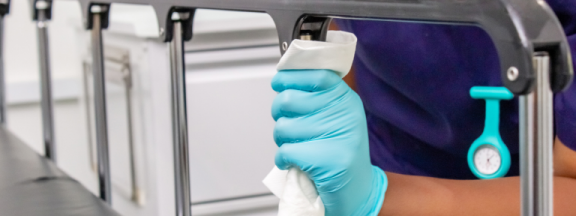
In healthcare, the ability of a disinfectant to eliminate spores, especially Clostridioides difficile, is critical. Bacterial endospores are among the most resilient forms of microbial life, and their persistence in the hospital environment presents a serious infection risk1,2. One way to reduce this risk is by implementing an effective decontamination procedure utilising a sporicidal disinfectant3. But how do you know if a disinfectant is truly sporicidal?
How are sporicidal claims governed in Europe?
The EN 14885 provides a framework, outlining the mandatory test standards required to support specific antimicrobial claims, including sporicidal claims. According to the EN 14885, for a product to be classed as sporicidal, the following test must be demonstrated4:
- EN 17126: The quantitative suspension test that proves the disinfectant contains sporicidal properties. This test is the foundation of any sporicidal claim.
As of May 2025 a new practical test became mandatory for a wiping product, and this includes:
- EN 17846: The quantitative surface test using wipes, demonstrates that the disinfectant, when applied under more practical conditions, via a wipe, retains sporicidal performance on a surface.
Both EN 17126 and EN 17846 tests are required to credibly and compliantly support a wiping product that claims sporicidal activity4,5.
Not all chemistries can be sporicidal
It is accepted and evidenced in healthcare that oxidising substances are capable of being sporicidal, however this is not the case for other types ofdisinfectants6.Quaternary ammonium compounds (QACs) are widely used in healthcare for their bactericidal, fungicidal, and virucidal properties, particularly against enveloped viruses. However, they are not capable of inactivating spores7.According to the Centers for Disease Control and Prevention (CDC):
“They are not sporicidal and generally not tuberculocidal or virucidal against hydrophilic (nonenveloped) viruses.8” —Chemical Disinfectants | Infection Control | CDC
The reason lies in their mode of action: QACs disrupt microbial membranes. However, spores lack active membranes and are encased in a highly resistant spore coat, making them inherently impervious to QACs’ primary mode ofaction9. While some studies suggest sporostatic effects (inhibiting germination), this is not the same as sporicidal activity – the ability to eliminate the spore itself7.
What does this mean for you?
Claims of sporicidal efficacy based solely on EN 17846, without evidence from EN17126, are incomplete and potentially misleading. A surface test alone is not sufficient to indicate true sporicidal activity4, and variable conditions can affect the products effectiveness10.This is about more than just passing a test, it’s about ensuring patient safety through the correct application of science and regulation. Disinfectant performance must be grounded in evidence, not marketing spin.
Key Takeaways
- Sporicidal claims must be verified with both EN 17126and EN 17846.
- QACs are not sporicidal, per CDC and peer-reviewed literature.
- Be wary of partial test claims presented as comprehensive proof.
If you’d like to know more about how Tristel test our disinfectants, please contact one of our sales representatives.
Because in infection prevention, clarity matters.
Our sporicidal disinfection solutions for surfaces in healthcare:
Reference:
- Kramer, A., Lexow, F., Bludau, A., Köster, A.M., Misailovski, M., Seifert, U.,Eggers, M., Rutala, W., Dancer, S.J. and Scheithauer, S. (2024). How long do bacteria, fungi, protozoa, and viruses retain their replication capacity on inanimate surfaces? A systematic review examining environmental resilience versus healthcare-associated infection risk by ‘fomite-borne risk assessment’. Clinical Microbiology Reviews. doi:https://doi.org/10.1128/cmr.00186-23.
- Assadian, O., Harbarth, S., Vos, M., Knobloch, J.K., Asensio, A. and Widmer, A.F. (2021). Practical recommendations for routine cleaning and disinfection procedures in healthcare institutions: a narrative review. Journal of Hospital Infection, [online] 113. doi:https://doi.org/10.1016/j.jhin.2021.03.010.
- Soroush Borji, Mosayeb Rostamian, Sepide Kadivarian, Kooti, S., ShirinDashtbin, Somayeh Hosseinabadi, Ramin Abiri and Amirhooshang Alvandi (2022).Prevalence of Clostridioides difficile contamination in the healthcare environmentand instruments: A systematic review and meta-analysis. Germs, 12(3), pp.361–371.doi:https://doi.org/10.18683/germs.2022.1340.
- British Standards Institution (BSI). EN 14885: Chemical Disinfectants and Antiseptics – Application of European Standards for Chemical Disinfectants and Antiseptics. Brussels: European Committee for Standardisation (CEN); 2022.
- Bolten, A., Schmidt, V. and Steinhauer, K. (2022). Use of the European standardization framework established by CEN/TC 216 for effective disinfection strategies in human medicine, veterinary medicine, food hygiene, industry, and domestic and institutional use – a review. DOAJ (DOAJ: Directory of Open Access Journals), 17, pp.Doc14–Doc14. doi:https://doi.org/10.3205/dgkh000417.
- Russell, A.D. (1990). Bacterial spores and chemical sporicidal agents. Clinical Microbiology Reviews, 3(2), pp.99–119.doi:https://doi.org/10.1128/cmr.3.2.99.
- Arnold, W.A., Blum, A., Branyan, J., Bruton, T.A., Carignan, C.C.,
Cortopassi, G., Datta, S., DeWitt, J., Doherty, A.-C., Halden, R.U., Harari, H.,Hartmann, E.M., Hrubec, T.C., Iyer, S., Kwiatkowski, C.F., LaPier, J., Li, D., Li, L.,Muñiz Ortiz, J.G. and Salamova, A. (2023). Quaternary Ammonium Compounds: A Chemical Class of Emerging Concern. Environmental Science & Technology,57(20). doi:https://doi.org/10.1021/acs.est.2c08244. - Rutala, W.A. and Weber, D.J. (2008). Guideline for disinfection and sterilization in healthcare facilities, 2008. Infection Control and Hospital Epidemiology,18, pp.240–264.
- Sharma, G. (2024). Quaternary Ammonium Disinfectants: Current Practices and Future Perspective in Infection Control: Review Article. Biomedical& Pharmacology Journal, 17(2), pp.677–685.doi:https://doi.org/10.13005/bpj/2895.
- Rabenau, H.F., Steinmann, J., Rapp, I., Schwebke, I. and Eggers, M.(2014). Evaluation of a Virucidal Quantitative Carrier Test for Surface Disinfectants. PLoS ONE, 9(1), p.e86128.doi:https://doi.org/10.1371/journal.pone.0086128.



